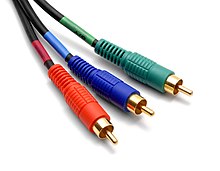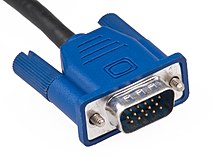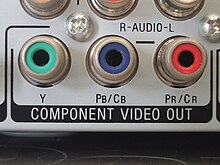Component video
This article needs additional citations for verification. (May 2008) |

Component video is a video signal that has been split into two or more component channels. In popular use, it refers to a type of component analog video (CAV) information that is transmitted or stored as three separate signals. Component video can be contrasted with composite video (NTSC, PAL or SECAM) in which all the video information is combined into a single line-level signal that is used in analog television. Like composite, component-video cables do not carry audio and are often paired with audio cables.
When used without any other qualifications the term component video usually refers to analog YPBPR component video with sync on luma.
Analog component video
Reproducing a video signal on a display device (for example, a Cathode ray tube (CRT)) is a straightforward process complicated by the multitude of signal sources. DVD, VHS, computers and video game consoles all store, process and transmit video signals using different methods, and often each will provide more than one signal option. One way of maintaining signal clarity is by separating the components of a video signal so that they do not interfere with each other. A signal separated in this way is called "component video". S-Video, RGB and YPBPR signals comprise two or more separate signals, and thus are all component-video signals. For most consumer-level applications, analog component video is used; however, digital component video is becoming increasingly common in both computer and home-theater applications. Component video is capable of carrying various signals, such as 480i, 480p, 576i, 576p, 720p, 1080i, 1080p and beyond. Many new high definition TVs support the use of component video up to their native resolution.
RGB analog component video


The various RGB (red, green, blue) analog component video standards (e.g., RGBS, RGBHV, RGsB) use no compression and impose no real limit on color depth or resolution, but require large bandwidth to carry the signal and contain much redundant data since each channel typically includes much of the same black and white image. Most modern computers offer this signal via a VGA port. Many televisions, especially in Europe, utilize RGB via the SCART connector. All arcade games, other than early vector and black and white games, use RGB monitors.
Analog RGB is slowly falling out of favor as computers obtain better clarity using DisplayPort or Digital Visual Interface (DVI) digital connections, while home theater systems increasingly favor High-Definition Multimedia Interface (HDMI), in part because analog connections cannot easily be made to support digital rights management. RGB has never been common in North America for consumer electronics as S-Video was considered sufficient for consumer use, although RGB was used extensively in commercial, professional and high-end installations.[citation needed]
In addition to the red, green and blue color signals, RGB requires two additional signals to synchronize the video display. Several methods are used:
- composite sync, where the horizontal and vertical signals are mixed together on a separate wire (the S in RGBS)
- separate sync, where the horizontal and vertical are each on their own wire (the H and V in RGBHV; also the acronym HD/VD, meaning horizontal deflection/vertical deflection, is used)
- sync on green, where a composite sync signal is overlaid on the wire used to transport the green signal (SoG, Sync on G, or RGsB).
- sync on red or sync on blue, where a composite sync signal is overlaid on either the red or blue wire
Composite sync is common in the European SCART connection scheme (using pins 17 [ground] and 19 [composite-out] or 20 [composite-in]). RGBS requires four wires – red, green, blue and sync. If separate cables are used, the sync cable is usually colored yellow (as is the standard for composite video) or white.
Separate sync is most common with VGA, used worldwide for analog computer monitors. This is sometimes known as RGBHV, as the horizontal and vertical synchronization pulses are sent in separate channels. This mode requires five conductors. If separate cables are used, the sync lines are usually yellow (H) and white (V),[1] yellow (H) and black (V), or gray (H) and black (V).[2]
Sync on Green (SoG) is less common, and while some VGA monitors support it, most do not. Sony is a big proponent of SoG, and most of their monitors (and their PlayStation line of video game consoles) use it. Like devices that use composite video or S-video, SoG devices require additional circuitry to remove the sync signal from the green line. A monitor that is not equipped to handle SoG will display an image with an extreme green tint, if any image at all, when given a SoG input.
Sync on red and sync on blue are even rarer than sync on green, and are typically used only in certain specialized equipment.
Luma-based analog component video

Further types of component analog video signals do not use separate red, green and blue components but rather a colorless component, termed luma, which provides brightness information (as in black-and-white video). This combines with one or more color-carrying components, termed chroma, that give only color information. Both the S-Video component video output (two separate signals) and the YPBPR component video output (three separate signals) seen on DVD players are examples of this method.
Converting video into luma and chroma allows for chroma subsampling, a method used by JPEG and MPEG compression schemes to reduce the storage requirements for images and video (respectively).
Many consumer TVs, DVD players, monitors, video projectors and other video devices use YPBPR output or input.
When used for connecting a video source to a video display where both support 4:3 and 16:9 display formats, the PAL television standard provides for signaling pulses that will automatically switch the display from one format to the other.
Connectors used
- D-Terminal: Used mostly on Japanese electronics.
- Three BNC (professional) or RCA connectors (consumer): Typically colored green (Y), blue (PB) and red (PR).
- SCART used in Europe.
- Video In Video Out (VIVO): 9-pin Mini-DIN-connectors called "TV Out" in computer video cards, which usually include an adaptor for component RCA, composite RCA and 4-pin S-Video-Mini-DIN.
International standards
Examples of international component video standards are:
- RS-170 RGB (525 lines, based on NTSC timings, now EIA/TIA-343)
- RS-343 RGB (525, 625 or 875 lines)
- STANAG 3350 Analogue Video Standard (NATO military version of RS-343 RGB, now EIA-343A)
- CEA-770.3 High Definition TV Analog Component Video Interface Consumer Electronics Association
Component versus composite
In a composite signal, the luminance, Brightness (Y) signal and the chrominance, Color (C) signals are encoded together into one signal. When the color components are kept as separate signals, the video is called component analog video (CAV), which requires three separate signals: the luminance signal (Y) and the color difference signals (R-Y and B-Y).
Since component video does not undergo the encoding process, the color quality is noticeably better than composite video.[3]
Component video connectors are not unique in that the same connectors are used for several different standards; hence, making a component video connection often does not lead to a satisfactory video signal being transferred. Many DVD players and TVs may need to be set to indicate the type of input/output being used, and if set incorrectly the image may not be properly displayed. Progressive scan, for example, is often not enabled by default, even when component video output is selected.
See also
References
- ^ Audio/Video Overview - types of signals
- ^ How to Use the 9A65 Component to RGB Video Converter
- ^ "Video Signal: Composite vs. Component". Apple Support. 3 October 2008. Retrieved 25 April 2011.
External links
- Poynton, Charles (November 28, 2006). "Color FAQ- Frequently Asked Questions about Color". Retrieved 2009-06-28.
